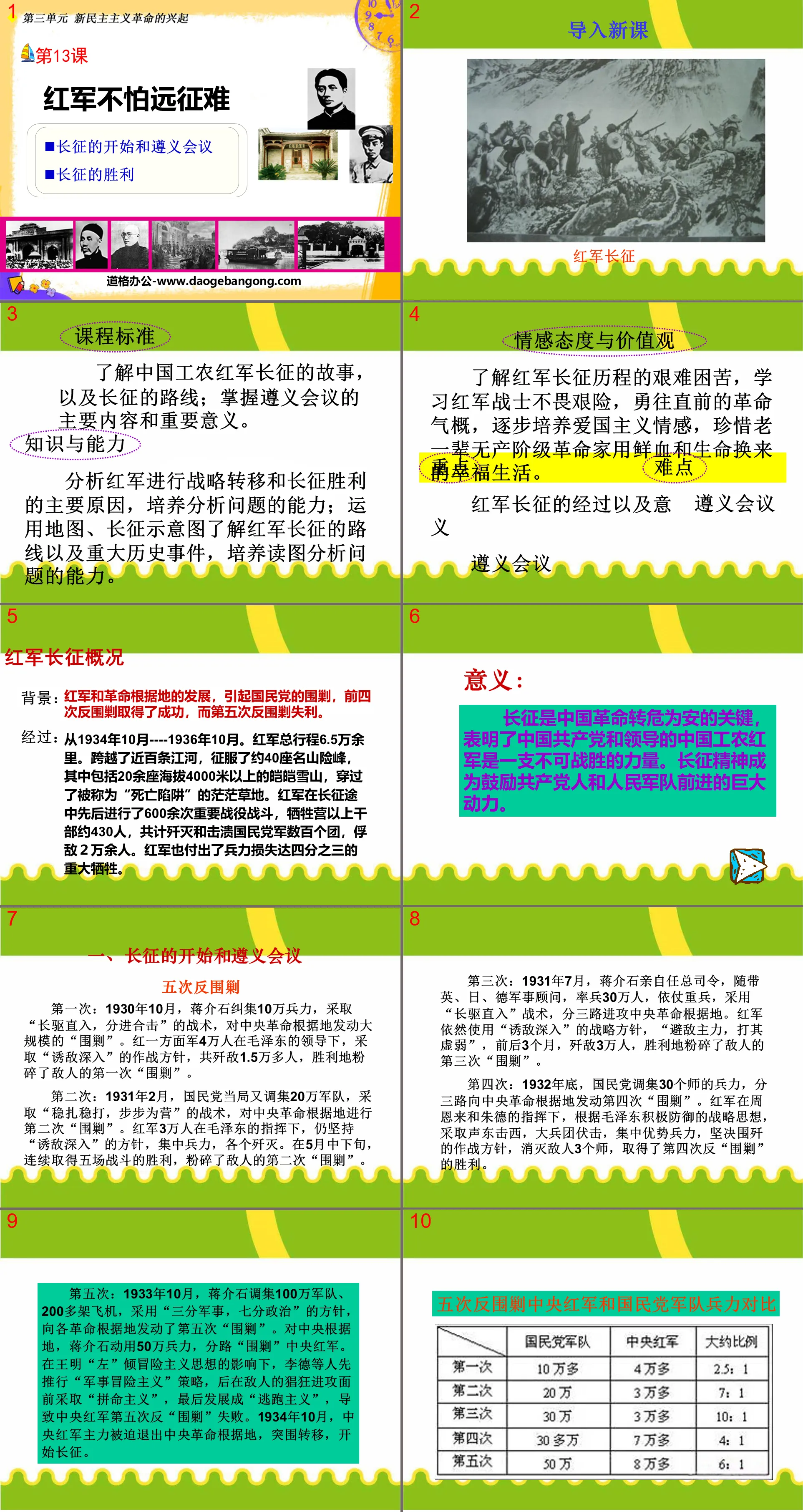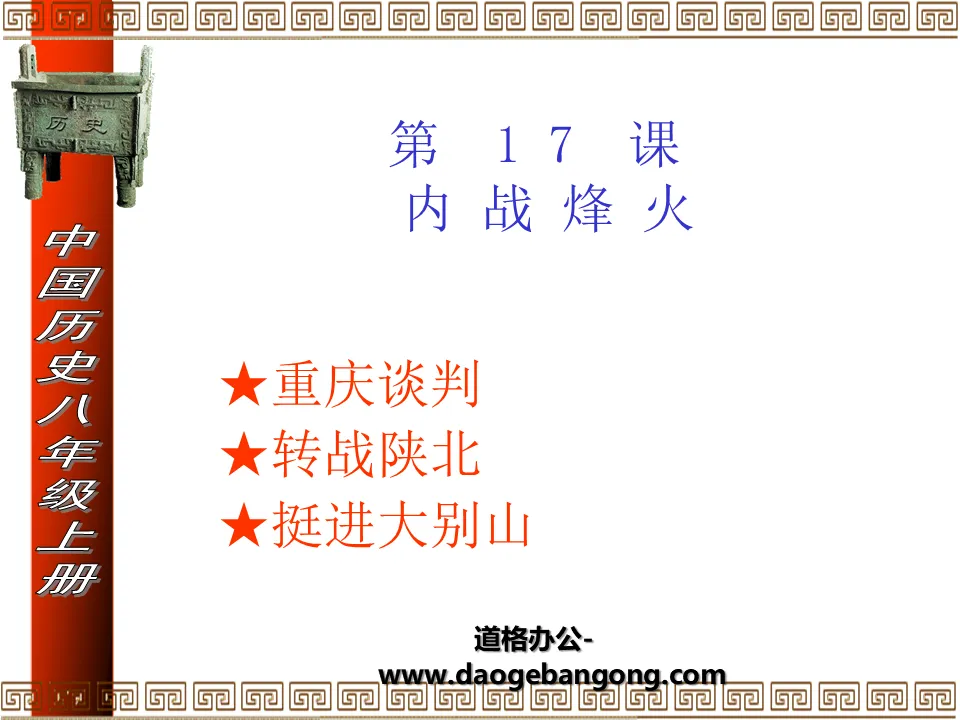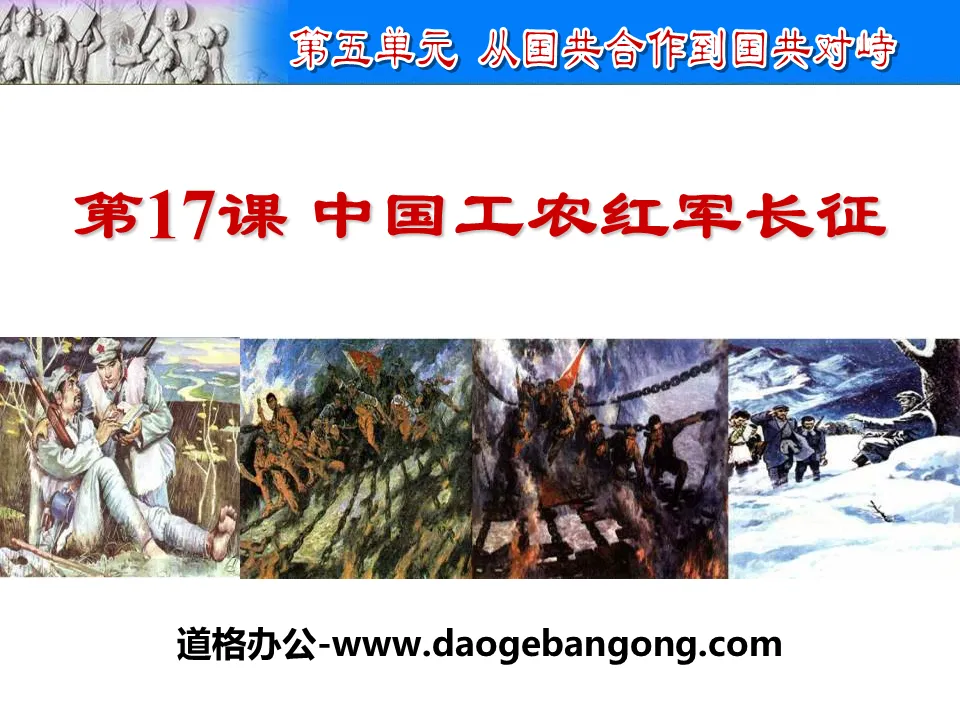
| Category | Format | Size |
|---|---|---|
| People's Education Edition Eighth Grade History Volume 1 | pptx | 6 MB |
Description
"The Red Army is Not Afraid of Difficulties in Expedition" The Rise of the New Democratic Revolution PPT Courseware
Curriculum Standards
Understand the story of the Long March of the Chinese Workers’ and Peasants’ Red Army and the route of the Long March; master the main content and significance of the Zunyi Conference.
knowledge and abilities
Analyze the main reasons for the Red Army's strategic shift and the victory of the Long March, and cultivate the ability to analyze problems; use maps and Long March diagrams to understand the route of the Red Army's Long March and major historical events, and cultivate the ability to read maps and analyze problems.
Emotional attitudes and values
Understand the hardships and hardships of the Red Army's Long March, learn the revolutionary spirit of the Red Army soldiers who were not afraid of hardships and dangers, and march forward courageously, gradually cultivate patriotism, and cherish the happy life that the older generation of proletarian revolutionaries exchanged with their blood and lives.
Overview of the Red Army's Long March
Background: The development of the Red Army and the revolutionary base areas triggered the Kuomintang's encirclement and suppression. The first four counter-encirclement and suppression campaigns were successful, but the fifth counter-encirclement and suppression campaign failed.
Passage: from October 1934 to October 1936. The total journey of the Red Army was more than 65,000 miles. He crossed nearly a hundred rivers, conquered about 40 famous mountains and dangerous peaks, including more than 20 snow-capped mountains above 4,000 meters above sea level, and passed through vast grasslands known as "death traps". During the Long March, the Red Army fought more than 600 important battles and sacrificed about 430 cadres above the battalion level. In total, it annihilated and defeated hundreds of regiments of the Kuomintang army and captured more than 20,000 enemy soldiers. The Red Army also made heavy sacrifices with the loss of three-quarters of its troops.
Significance: The Long March was the key to turning the Chinese revolution from crisis to safety. It showed that the Communist Party of China and the Chinese Workers’ and Peasants’ Red Army led by the Communist Party of China were an invincible force. The spirit of the Long March became a huge driving force to encourage the Communists and the people's army to move forward.
1. The Beginning of the Long March and the Zunyi Conference
The first time: In October 1930, Chiang Kai-shek gathered 100,000 troops and adopted the tactics of "driving straight in, advancing separately and attacking together" to launch a large-scale "encirclement and suppression" against the central revolutionary base area. Under the leadership of Mao Zedong, the 40,000-strong Red Front Army adopted the combat policy of "lubing the enemy deep" and annihilated more than 15,000 enemies in total, successfully crushing the enemy's first "encirclement and suppression" campaign.
The second time: In February 1931, the Kuomintang authorities mobilized another 200,000 troops and adopted the tactics of "fighting steadily and making camp step by step" to carry out the second "encirclement and suppression" of the Central Revolutionary Base Area. Under the command of Mao Zedong, the 30,000-strong Red Army still adhered to the policy of "lubing the enemy deep into the territory", concentrating its forces and annihilating them one by one. In mid-to-late May, we won five consecutive battles and crushed the enemy's second "encirclement and suppression" campaign.
The third time: In July 1931, Chiang Kai-shek personally served as commander-in-chief, accompanied by British, Japanese and German military advisers, led 300,000 troops, relied on heavy troops, and adopted the "long drive and direct attack" tactic to attack the central revolutionary base area in three directions. The Red Army still used the strategic policy of "lubing the enemy deep" and "avoiding the enemy's main force and attacking its weakness". In three months, it annihilated 30,000 enemies and successfully crushed the enemy's third "encirclement and suppression" campaign.
Fourth: At the end of 1932, the Kuomintang mobilized 30 divisions and launched the fourth "encirclement and suppression" campaign against the Central Revolutionary Base Area in three directions. The Red Army, under the command of Zhou Enlai and Zhu De, based on Mao Zedong's strategic thinking of active defense, adopted the operational policy of attacking in the east, attacking in the west, ambushing large corps, concentrating superior forces, and resolutely encircling and annihilating them. It eliminated three enemy divisions and achieved the fourth victory in countering "encirclement and suppression". victory.
central revolutionary base area
The Central Revolutionary Base Area, also known as the Central Soviet Area, is located in southern Jiangxi and western Fujian. It was the largest revolutionary base area in the country during the Agrarian Revolutionary War. It was the central area of the national Soviet movement and the seat of the party, government, and military leaders of the Chinese Soviet Republic. The Central Revolutionary Base Area was created based on the two base areas of southern Jiangxi and western Fujian. By the autumn of 1933, the Central Soviet Area had jurisdiction over four provincial-level Soviet regimes: Jiangxi, Fujian, Fujian-Jiangxi, and Guangdong-Jiangxi, and had 60 administrative counties. The Red Army and its base areas had reached their peak. The Central Soviet Area thus became the largest revolutionary base area in the country.
Soviet Republic of China
It was founded on November 7, 1931 by the Communist Party of China, and its capital is Ruijin, Jiangxi. During the regime's operation, its central government promulgated a constitution, issued currency, designed a national flag, and called the areas under its control "Soviet Areas." Due to the failure of the fifth anti-"encirclement and suppression" campaign, the Provisional Central Government of the Chinese Soviet Republic was forced to evacuate the Central Soviet Area in October 1934 and moved to the Shaanxi-Gansu-Ningxia Soviet Area in October 1935. The cancellation was announced on September 22, 1937.
2. Victory of the Long March
In October 1935, the Central Red Army arrived at Wuqi Town in the Shaanxi-Gansu Revolutionary Base Area. In October 1936, the Second and Fourth Front Army of the Red Army successfully joined forces with the First Front Army of the Red Army in Huining, Gansu Province. The victory of the three main forces announced that the Red Army had 25,000 troops. The successful conclusion of the Thousand-mile Long March brought the Chinese revolution out of danger.
The "Long March Spirit" is the highest expression of the Chinese nation's national spirit of perseverance and self-improvement. "The spirit of the Long March can be summed up as the spirit of adhering to revolutionary ideals and beliefs and firmly believing that a just cause will win; the spirit of sacrifice without fear of hardships and obstacles; the spirit of independence and seeking truth from facts; the spirit of keeping the overall situation in mind and close unity; the spirit of tight unity; The spirit of relying closely on the masses and sharing weal and woe; the spirit of revolutionary heroism and optimism that goes forward courageously. —— Zhang Rongchen, Professor of the Party School of the Central Committee
Do you think the Long March spirit is outdated? Why?
Currently, the Communist Party of China is leading the people across the country in the great cause of building a prosperous, democratic, civilized, and harmonious modern socialist country. This undertaking has a long way to go and is a new, greater and more arduous Long March led by the people of the country under the new situation. The revolutionary fire sown by the Long March will continue to bear fruit, inspiring us to overcome any difficulties and obstacles on our new journey. Therefore, the spirit of the Long March will never go out of style and will be passed down from generation to generation.
training camp
1. During the Long March, the Red Army jumped out of the enemy's encirclement when ( )
A. After breaking through the enemy's four blockades,
B. After crossing the Chishui River for the fourth time
C. After crossing the Jinsha River
D. After forcibly crossing the Dadu River
2. Suizhou Baiyun School held the "Re-walking the Long March" activity class competition. Student Zhang Qiang prepared to recreate the following historical scenes in the speech activity. Among them, the inappropriate ones are ( )
A. Crossing the Chishui River four times
B. Flying to seize Luding Bridge
C. Climb the snowy mountains
D. Join Jinggangshan
3. Red tourism is one of the ways for young people to receive revolutionary traditional education. Classmate Xiao Ling is traveling during the summer vacation. She wants to follow the order of historical events. Can you design it for her? ( )
① Zunyi Conference ② The fifth counter-campaign against "encirclement and suppression"
③Wu Qizhen joins forces ④Huining joins forces
A. ①②③④ B. ②④③①
C. ①②④③ D. ②①③④
4. "The Red Army is not afraid of the difficulties of the expedition, and it only waits for thousands of rivers and mountains." The Red Army's "Expedition" ( )
A. It was to go north to fight against Japan
B. Preserved the core strength of the Party and the Red Army
C. It is a proactive strategic shift
D. Smashed the fifth "encirclement and suppression" campaign by the Kuomintang troops
Material one:
The Red Army is not afraid of the difficulties of the expedition, and it can only wait for thousands of rivers and mountains. The five ridges are meandering and the waves are flowing, and the fog is majestic and the mud balls are walking.
The golden sand and water are warm against the clouds and the cliffs are warm, while the iron cables across the Dadu Bridge are cold. I am even more happy that there is thousands of miles of snow in Minshan Mountain, and the three armies are all happy after the passing.
Material 2: Schematic diagram of observing the Long March:
Please answer:
(1) Who wrote material one about the incident? What was the reason for this incident? What is its nature?
(2) The four places A, B, C, and D in Material 2 are ___, ___, ___, and ___ respectively (fill in the place name)
(3) In Material 1, it is written that "The Red Army is not afraid of difficulties during the expedition." Combined with Material 2 and the knowledge you have learned, what difficulties and obstacles do you think the Red Army overcame during the Long March? (2 is enough)
(4) What is the historical significance of the victory in this struggle? From the materials, what revolutionary spirit of the Red Army can be seen that is worth learning?
Reference answer
(1) Mao Zedong’s Long March for the Chinese Workers’ and Peasants’ Red Army. The fifth counter-encirclement and suppression campaign failed. The Long March was a forced strategic shift.
(2) Ruijin, Zunyi, Wuqizhen, Huining.
(3) The Kuomintang's pursuit and interception; the interference of "left" errors within the Communist Party; the harsh natural environment; the complexity of ethnic relations, etc. (You can answer any two of them)
(4) The victory of the Long March shattered the attempts of the Kuomintang reactionaries to stifle the Chinese revolution and turned the Chinese revolution out of danger; it preserved the core strength of the party and the Red Army; and promoted the arrival of a new situation in the Chinese revolution. The spirit of revolutionary optimism and the style of hard work and simplicity that are not afraid of hardships and hardships. (It just makes sense)
Keywords: The Rise of the New Democratic Revolution teaching courseware, the Red Army is not afraid of the difficult expedition teaching courseware, the People's Education Edition eighth grade history PPT courseware download, the eighth grade history slide courseware download, the rise of the new democratic revolution PPT courseware download, the Red Army is not afraid Expedition Difficulties PPT courseware download, .PPT format;
For more information about the PPT courseware "The Rise of the New Democratic Revolution, the Red Army Is Not Afraid of Difficulties in Expeditions", please click the "The Rise of the New Democratic Revolution, The Red Army Is Not Afraid of Difficulties in Expeditions" ppt tag.
"The Red Army is Not Afraid of Difficulties in Expedition" The Rise of the New Democratic Revolution PPT Courseware 7:
"The Red Army Is Not Afraid of Difficulties in Expedition" The Rise of the New Democratic Revolution PPT Courseware 7 1. The Beginning of the Long March 1. Smash the enemy's four sieges on the base area. As the base area grew and developed, the enemy was very frightened. From October 1930 to the spring of 1933, successive attacks Four rounds of inspections were carried out on the base area...
"The Red Army is Not Afraid of Difficulties in Expedition" The Rise of the New Democratic Revolution PPT Courseware 6:
"The Red Army is Not Afraid of the Difficulties of the Expedition" The Rise of the New Democratic Revolution PPT Courseware 6 Teaching Objectives Knowledge and Ability 1. Be able to tell the reasons why the Party and the Central Red Army were forced to carry out the Long March; 2. Be able to summarize the great historical significance of the Red Army's Long March and the Zunyi Conference ; 3. Ability to...
"The Red Army is Not Afraid of Difficulties in Expedition" The Rise of the New Democratic Revolution PPT Courseware 5:
"The Red Army Is Not Afraid of Difficulties in Expedition" The Rise of the New Democratic Revolution PPT Courseware 5 The Red Army's Fifth Counter-Encirclement and Suppression --- Failure Due to the wrong command of Bogu, Li De and others, the Red Army failed to crush the enemy's fifth encirclement and suppression. The Party Central Committee was forced to abandon the central revolutionary base and conduct strategic shifts..
File Info
Update Time: 2024-07-15
This template belongs to History courseware People's Education Edition Eighth Grade History Volume 1 industry PPT template
"The Red Army is Not Afraid of Difficulties in Expedition" The Rise of the New Democratic Revolution PPT Courseware Simple campus recruitment activity planning plan summary enterprise and institution recruitment publicity lecture PPT template is a general PPT template for business post competition provided by the manuscript PPT, simple campus recruitment activity planning plan summary enterprise and institution recruitment promotion Lecture PPT template, you can edit and modify the text and pictures in the source file by downloading the source file. If you want more exquisite business PPT templates, you can come to grid resource. Doug resource PPT, massive PPT template slide material download, we only make high-quality PPT templates!
Tips: If you open the template and feel that it is not suitable for all your needs, you can search for related content "The Red Army is Not Afraid of Difficulties in Expedition" The Rise of the New Democratic Revolution PPT Courseware is enough.
How to use the Windows system template
Directly decompress the file and use it with office or wps
How to use the Mac system template
Directly decompress the file and use it Office or wps can be used
Related reading
For more detailed PPT-related tutorials and font tutorials, you can view: Click to see
How to create a high-quality technological sense PPT? 4 ways to share the bottom of the box
Notice
Do not download in WeChat, Zhihu, QQ, built-in browsers, please use mobile browsers to download! If you are a mobile phone user, please download it on your computer!
1. The manuscript PPT is only for study and reference, please delete it 24 hours after downloading.
2. If the resource involves your legitimate rights and interests, delete it immediately.
3. Contact information: service@daogebangong.com
"The Red Army is Not Afraid of Difficulties in Expedition" The Rise of the New Democratic Revolution PPT Courseware, due to usage restrictions, it is only for personal study and reference use. For commercial use, please go to the relevant official website for authorization.
(Personal non-commercial use refers to the use of this font to complete the display of personal works, including but not limited to the design of personal papers, resumes, etc.)
Preview




















